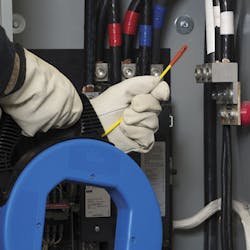Ideal Industries notes that electricians and information transport systems installers use fish tapes on a daily basis to snake electrical wires and communications cables through conduit, finished walls, and hard-to-reach spaces above ceilings and below flooring.
More news: Ideal Industries names new director of industrial sales
When handled correctly, fish tapes are indispensable tools for pulling wires fast and conveniently, while eliminating the need to demolish structural elements. However, in using fish tape, Ideal emphasizes that certain simple guidelines need to be followed to assure safe operation and to maintain equipment in top shape for years of service.
The company therefore offers the following 9 tips on the proper use of fish tape to assure safety and productivity:
1. Wear heady-duty gloves when fishing tape. Sharp edges or burrs can cut bare hands.
2. While feeding wire, coordinate with the worker pulling the wire so you can develop a steady tempo of pulling just a few feet at a time.
3. Keep fish tape clean of dirt and built-up lubricant by washing it with a gentle detergent and warm water. Dirty tape can be difficult to play out and retrieve. Inspect fish tapes and leaders for corrosion, cracks, or other wear that may lead to it breaking during pulling.
4. Cut down on friction during long or multiple-bend conduit runs with IDEAL wire pulling lubricant.
5. Steel tapes are the most widely used fish tapes, but for jobs near live circuits or in wet conditions, non-conductive, non-corrosion fiberglass tapes are a better choice.
6. If you encounter insulation, try to not go through it, but around it with the fish tape.
7. You can also substitute fish tape with an IDEAL Tuff-Rod flex fishing pole for added strength and control.
8. Before running fish tape in conduit that contains wires, disconnect the power.
9. Practice correct Lockout/Tagout procedures while working around energized electrical circuits. It may save your life.
Ideal has introduced a new version of its S-Class non-conductive fiberglass fish tape to promote increased safety, if unintentionally used around energized circuits. Designed to work inside Ideal's Tuff-Grip Pro cases, the S-Class fish tape features a non-conductive and non-arcing eyelet tip, so it minimizes the possibility for injury from accidental contact with electricity. In addition, the eyelet features streamlined ribs and a curved loop that reduces stress points on the fish tape while being pushed.
See also: When ladders wont fit, conduit/fish -tape combo comes to the rescue
About the Author
Matt Vincent
Senior Editor
Matt Vincent is a B2B technology journalist, editor and content producer with over 15 years of experience, specializing in the full range of media content production and management, as well as SEO and social media engagement best practices, for both Cabling Installation & Maintenance magazine and its website CablingInstall.com. He currently provides trade show, company, executive and field technology trend coverage for the ICT structured cabling, telecommunications networking, data center, IP physical security, and professional AV vertical market segments. Email: [email protected]

